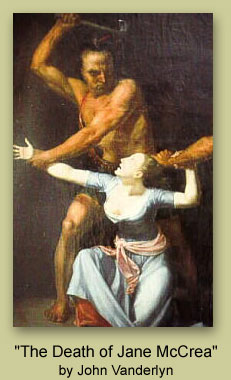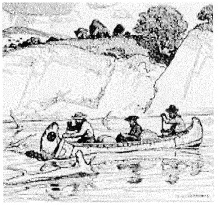| The French and Indian War
Like
other European nations, France also wanted to partake in the riches of By that time France had established a strong relationship with a number of Indian tribes in Canada and along the Great Lakes, taken possession of the Mississippi River and, by establishing a line of forts and trading posts, marked out a great crescent-shaped empire stretching from Quebec to New Orleans. Thus, the British were confined to the narrow belt east of the Appalachian Mountains. The French threatened not only the British Empire but the American colonists themselves, for in holding the Mississippi Valley, France could limit their westward expansion.
The French and Indian War is also called the Seven Years War and you should know that Native Americans fought on both sides. They were often very successful in battling the British, though textbooks tend to minimize their successes as well as the atrocities they faced. Here's a video summary for you:
Here's the reading you need for this assignment. 1. Why did Cartier come to the New World and how were his intentions the same or different than those of Christopher Columbus? 2. For what purpose(s) were French Fur Trading Companies formed? 3. Find a map or use this link (you'll have to scroll up and down and side to side to se it all). Where does the St. Lawrence river end? 4. Explain at least two reasons why Samuel de Champlain (link) is important. 5. Find a map again (link). Often called the sixth Great Lake at over 100 miles long, what state(s) or countries claim Lake Champlain? 6. What role did the Jesuits play in the New World? 7. Who were Father Marquette and Louis Joliet (link)? Do you know they camped along the Milwaukee River? Pierre Marquette Park between Kilbourn and State Street downtown has a plaque saying so. Oh, and now you know who Marquette University is named after - it is still staffed by Jesuit priests. 8. What contribution did the great explorer La Salle make? 9. How did the population of New France compare to that of the British colonies? 10. What role did the Iroquois play in the French and Indian War? 11. Where and why did George Washington lose his first battle? 12. Was General Braddock able to save Washington? 13. How were the British finally able to win the war? 14. What were the terms of the Treaty of Paris? 15. What language is still dominant in Quebec (link) the capital of Canada? (link) |
 the New World. So even before Columbus sailed a Frenchman named Jacques Cartier set out to find a passage to the Far East and ended up in
Newfoundland like the Vikings had. He was followed by Samuel
de Champlain who founded Quebec in 1608
- one year before the settlement at Jamestown. The French explorers came
to the New World looking for furs and other valuables to trade they thus
became friends with several tribes ofIndians who were able to
assist them. It is important to note that they were unlike the British -
for the British came to settle new lands on which to live.
the New World. So even before Columbus sailed a Frenchman named Jacques Cartier set out to find a passage to the Far East and ended up in
Newfoundland like the Vikings had. He was followed by Samuel
de Champlain who founded Quebec in 1608
- one year before the settlement at Jamestown. The French explorers came
to the New World looking for furs and other valuables to trade they thus
became friends with several tribes ofIndians who were able to
assist them. It is important to note that they were unlike the British -
for the British came to settle new lands on which to live.